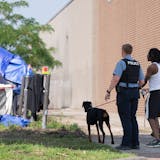Two years ago, the city of Minneapolis began rating apartment buildings based on their condition, maintenance and need for city services.
The best-kept buildings — dubbed Tier 1 — require inspections every eight years and pay a lower license fee. At the other end, Tier 3 buildings — the worst classification — must be inspected annually and pay higher prices for licenses. The goal, the city says, is to keep a close eye on the problem properties and make the landlords who own them pay for the extra effort.
But a review of the ratings shows they don't always square with the conditions at apartment buildings around the city. Landlord Stephen Frenz's buildings racked up 453 building violations from 2013 to March 2016, yet 61 of his 66 apartment buildings were rated in Tier 1 and the remaining five were rated Tier 2. And the classification of other apartment buildings also raises questions.
Of the 29 buildings with the most violations — and more than five violations per unit — between 2013 and March 2016, 14 were classified as Tier 1, according to city records.
"It's preposterous," said Roberto de la Riva, an organizer with Inquilinxs Unidxs Por Justicia (United Renters for Justice), which has been mobilizing tenants for more than a year to protest conditions in Frenz's properties. "It shows a weakness in the system."
City officials said the tier system continues to be tweaked. New data provided by the city showed that seven of the worst 29 properties are now rated Tier 1, six are Tier 2, and 16 are Tier 3.
"We make adjustments as they are appropriate," said Noah Schuchman, director of regulatory services in Minneapolis.
Building gets high marks
One of Frenz's Minneapolis properties classified as Tier 1 by the city is an apartment building in the 3000 block of 14th Av. S.



